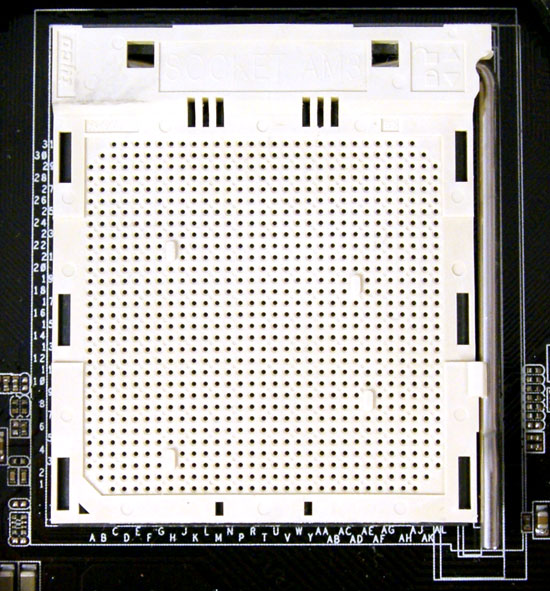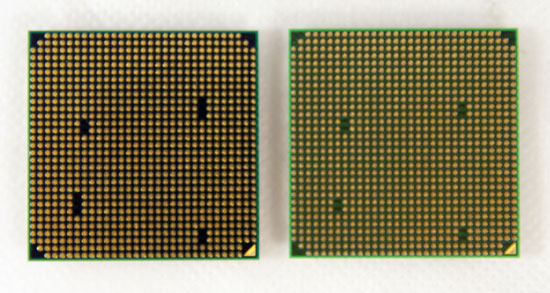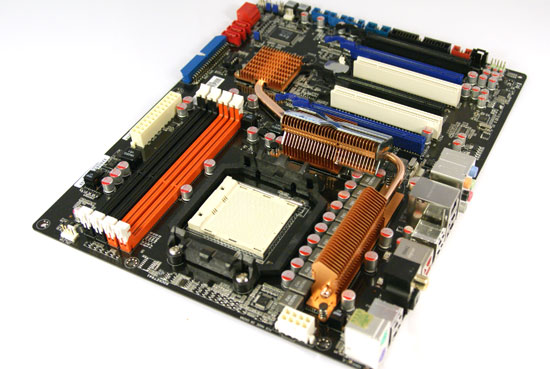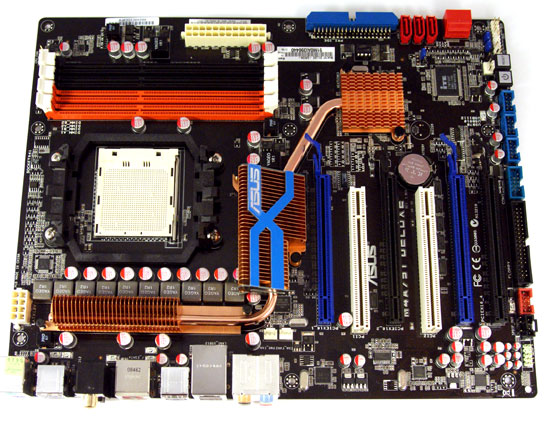The Phenom II X4 810 & X3 720: AMD Gets DDR3 But Doesn't Need It
by Anand Lal Shimpi on February 9, 2009 12:00 AM EST- Posted in
- CPUs
Lower TDPs, Faster un-core, DDR3 Support: The new Phenom II
All of the CPUs launching today are Socket-AM3 compatible. If you remember from my original Phenom II article, a Socket-AM3 CPU can work in both AM3 and AM2+ motherboards. I made a cute little compatibility matrix for you guys:
| CPU/Motherboard | Socket-AM2 MB | Socket-AM2+ MB | Socket-AM3 MB |
| Socket-AM2 CPU | Yes | Yes | No |
| Socket-AM2+ CPU | Maybe | Yes | No |
| Socket-AM3 CPU | Maybe | Yes | Yes |
AMD carefully engineered its AM3 memory controller allowing it to operate in both DDR2 and DDR3 modes. Any AM3 CPU can thus work in either a Socket-AM3 motherboard with DDR3 memory, or in a Socket-AM2+ motherboard with DDR2 memory. Backwards compatibility with original Socket-AM2 motherboards is up to the motherboard vendor, AMD does not validate any AM3 CPUs in regular AM2 motherboards.

The new Socket-AM3. Socket-AM2/AM2+ CPUs won't fit in here. But AM3 CPUs will fit in AM2+ boards.
All of the Socket-AM3 Phenom II CPUs are 95W TDP parts, compared to 125W for the first two chips that launched in January. The other notable change is that all of the AM3 CPUs run their un-core (North Bridge + L3 cache) at 2.0GHz instead of 1.8GHz like the AM2+ Phenom II processors.
Socket-AM3 Motherboards: Don't Bother Yet
I've had a Socket-AM3 motherboard here for a while but honestly the performance just isn't worth it. While it's taken a while to get stability up to par with AM2+, overall system performance remains unaffected. The Socket-AM2+ to Socket-AM3 transition looks a lot like the Socket-939 to Socket-AM2 transition we saw back in 2006.

A Socket-AM3 CPU (left) vs. a Socket-AM2 CPU (right) Note the missing pins on the AM3 chip.
Thankfully AMD gives you the option to ugprade whenever you'd like. You can buy a Socket-AM3 CPU today and use it in either an AM2+ board or an AM3 board, provided there's proper BIOS support. DDR3 memory is still more expensive than DDR2 and offers no real world performance advantage even at DDR3-1333 speeds.


Note that Socket-AM3 CPUs will only officially support one DIMM per channel running at 1333MHz. You'll need to run at 1066MHz speeds if you're running four DIMMs. When DDR2 and DDR3 memory reach price parity at the end of this year, AMD will be in a good position to make the transition. But if you're buying today, find a good AM2+ board and some cheap DDR2 memory.
The Test
| Motherboard: | Intel DX58SO (Intel X58) Intel DX48BT2 (Intel X48) MSI DKA790GX Platinum (AMD 790GX) |
| Chipset: | Intel X48 Intel X58 AMD 790GX |
| Chipset Drivers: | Intel 9.1.1.1010 (Intel) AMD Catalyst 8.12 |
| Hard Disk: | Intel X25-M SSD (80GB) |
| Memory: | G.Skill DDR2-800 2 x 2GB (4-4-4-12) G.Skill DDR2-1066 2 x 2GB (5-5-5-15) Qimonda DDR3-1066 4 x 1GB (7-7-7-20) |
| Video Card: | eVGA GeForce GTX 280 |
| Video Drivers: | NVIDIA ForceWare 180.43 (Vista64) NVIDIA ForceWare 178.24 (Vista32) |
| Desktop Resolution: | 1920 x 1200 |
| OS: | Windows Vista Ultimate 32-bit (for SYSMark) Windows Vista Ultimate 64-bit |










77 Comments
View All Comments
7Enigma - Monday, February 9, 2009 - link
Ditto the power consumption at OC'd levels. I always get annoyed to see these fantastic OC results but then fail to see whether we've doubled the power consumption. It would certainly allow us to see a potential benefit if one or the other uses significantly less power under OC load conditions.Gary Key - Monday, February 9, 2009 - link
We will have power consumption and temps up tomorrow for the OC results along with a few benchmarks. It was difficult to get stable (true) volt readings with the X4 810 installed, so I spent my weekend with the DMM on the boards.Kaleid - Monday, February 9, 2009 - link
Great! Possible to also add difference with non-overclocked and overclocked power consumption at idle?7Enigma - Monday, February 9, 2009 - link
At the wall (total system) or just for the CPU? Do you mean the total system power was fluctuating with the 810? That seems really really wierd.Gary Key - Monday, February 9, 2009 - link
The power was fluctuating on the board at the Core VID side. I should have a BIOS spin tonight to fix it. The 720 was perfect but the 810 had a few problems that have been identified now.7Enigma - Monday, February 9, 2009 - link
*weird, please give us an edit function.OCedHrt - Monday, February 9, 2009 - link
Interestingly, the 810 vs 910, there is no real performance difference outside the margin of error. In some cases, the 810 is faster and in some, the 910 takes the lead. Something I noticed though is that the 810 is faster than the 910 at more times, and faster by a larger amount (~3% when it is faster) as well. Seems like the reduced cache does not actually hamper performance.Moorbo - Friday, April 24, 2009 - link
For most applications it seems you're correct that the smaller cache makes little difference. However if you look at the gaming performance the 2MB/core L3 cache of the 720 and 710 clearly makes a big difference despite their slower clock and lack of an additional core. What would the numbers look like with only two cores and 3MB/core and a higher clock?johnsonx - Monday, February 9, 2009 - link
indeed, the 710 is also often faster than the 910, but usually slower than the 810.I'm a bit surprised we the readers have to thumb through all the benchmark charts to see the 710/810/910 comparison. 3 Phenom II's at the same speed, one 'standard', one with less cache and one with a missing core; that is something AT should have dedicated a page to.
stmok - Monday, February 9, 2009 - link
Yeah, I noticed that as well. It looks like 4MB L3 cache is sufficient with Phenom II. (Any less, it'll start hurting...Any more, you're just wasting silicon space).